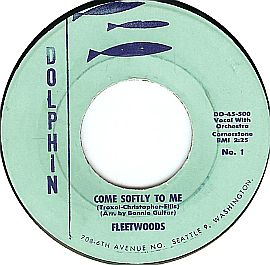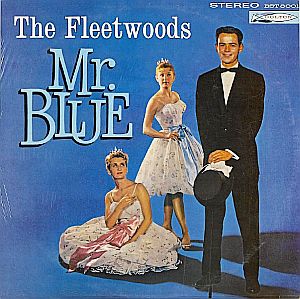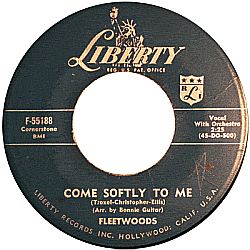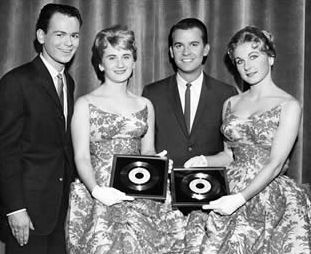
1959: The Fleetwoods with American Bandstand's Dick Clark, receiving gold records for “Come Softly to Me” and “Mr. Blue.”
For a time in 1959-1963, the songs of The Fleetwoods – and in particular, “Come Softly to Me” and another hit, “Mr. Blue” – shot to the top of the music charts and were very popular.
The sound of The Fleetwoods was sweet and melodic with good harmonies, engaging arrangement, and tender lyrics; a style that flourished briefly amid the more raucous rock ’n roll of Jerry Lee Lewis and other hard rockers of that day.
But several years later, the pop music landscape would be transformed with the arrival of the Beatles and other British groups – the “British invasion,” as it was sometimes called – which would take popular music in a new direction. But for a time, The Fleetwoods’ sound became very popular.
As teenagers in Olympia, Washington, Gretchen Christopher, Barbara Ellis, and Gary Troxel attended Olympia High School. One of the songs they had written and performed at school functions – then named “Come Softly” – had struck a cord with their classmates who wanted copies. The group was then known as “Two Girls and A Guy.”Music Player
“Come Softly to Me” – 1959
The Fleetwoods
Within six months or so they managed to make a recording of their song, and soon met Bob Reisdorff, owner of Dolphin Records. Reisdorff suggested two changes: adopt a new group name, which they did, choosing “The Fleetwoods,” based on a local telephone exchange, and rename their song to “Come Softly to Me,” which they also did.
The year 1959 had something of an era-ending aura about it. Dwight Eisenhower was still president of the United States, completing his second term. U.S. Senators Jack Kennedy and Hubert Humphrey were then maneuvering to be considered for the Democratic Party’s 1960 Presidential nomination, as incumbent Vice President Richard Nixon was the likely Republican candidate. In film that year, Ben Hur, North By Northwest, and Some Like It Hot were among the top box office attractions. Exodus, Dr. Zhivago and The Ugly American were among the best-selling books.
Early 1959 had seen pop music hits such as “Smoke Gets in Your Eyes” by the Platters and “Stagger Lee” by Lloyd Price. Musically, this was still the era of the crooners, but a few teen idols such as Frankie Avalon had hits, too. Avalon had the No. 1 “Venus” in March 1959. The Fleetwoods, meanwhile, released their song, “Come Softly to Me,” in the spring of 1959. It rose steadily on the Billboard music chart, reaching No. 1 on April 13, 1959, staying there for four weeks through May 10, 1959. The success of this song for the Fleetwoods, and a few others to follow, marked one of the first big national success stories for a Pacific Northwest pop music group.
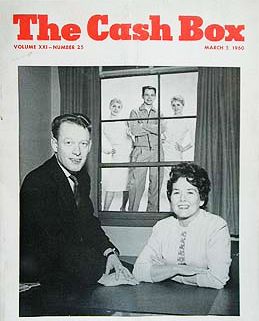
Bob Reisdorff and Bonnie Guitar of Dolphin Records with The Fleetwoods in the background, “Cash Box” magazine, March 5, 1960.
Back Story
The rise of the Fleetwoods’ first song came about, in part, after a former singer named Bonnie Guitar – a Northwest pop star who in 1957 had a Top Ten hit called “Dark Moon” – joined Dolphin records as a vice president. During her Hollywood years before returning to Seattle she had learned the ins and outs of record production, and after hearing “Come Softly” she agreed it had “a hit sound.” The song was recorded on February 18th, 1959 at the Seattle studio of Joe Boles Custom Recorders, with Bonnie Guitar helping in production. She trimmed the song’s length to a shorter pop form and contributed her own background guitar work to the song. A sparse musical arrangement was also used to highlight the innocent sound and harmonies.
The newly-minted Dolphin single (Dolphin label later became Dolton) was then taken around to Seattle’s King radio stations and others, including KOL, KJR, KUTI, and KAYO. “Come Softly to Me” soon built to a statewide following becoming a hit, and then proceeded to move down the West Coast. As “Come Softly To Me” rose on U. S. national pop and R&B charts, and also abroad in the U.K., it became the first million-seller ever in the Pacific Northwest. Bob Reisdorff of the Dolphin/Dolton label then cut a distribution deal with a Los Angeles-based label, Liberty Records. The Seattle Post-Intelligencer wrote that the song had become a surprise-hit, shipping over 100,000 copies. It was also No. 1 in the Miami and Cleveland markets. The Fleetwoods, meanwhile, quit their day jobs and college courses in order to begin their first national tour. Suddenly, they found themselves making TV appearances on American Bandstand, The Dick Clark Show, and The Ed Sullivan Show. They made their first national appearance on March 14, 1959, on The Dick Clark Show. They appeared on the Sunday night Ed Sullivan Show on April 5, 1959. “Come Softly To Me” now started to sell in even larger quantities. It moved swiftly up the charts, into the Top Twenty in two weeks and to No. 1 by mid-April. As “Come Softly To Me” rose on U. S. national pop and R& B charts, and also abroad in the U.K., it became the first million-seller ever in the Pacific Northwest.
“Mr. Blue”
The Fleetwoods weren’t able to immediately produce a follow-up single as successful as “Come Softly,” but they soon found another hit in their third single, “Mr. Blue.” Released in August 1959, this song, written by DeWayne Blackwell, also became a million seller.
Music Player
“Mr. Blue” – 1959
The Fleetwoods
“Mr. Blue” became a No. 1 pop hit and No. 5 R&B hit in the U.S., staying near the top of the charts through the end of 1959. “Mr. Blue’s” ascendancy to No. 1 helped mark the Fleetwoods with a singular distinction at the time, becoming the first vocal group to have multiple No.1 hits on the Billboard Hot 100 in single year. Other individual singers and groups in the 1950s had accomplished that prior to the onset of the Billborad Hot 100, among them Eddie Fischer and Pat Boone. The Everly Brothers also had two No. 1 hits in 1958, straddling the Billboard era. Elvis Presley, of course, also pre-Billboard Hot 100, had multiple No. 1 hits in a single year – five in 1956, four in 1957, and two in 1958. By 1962, the Four Seasons would also notch two No. 1 hits – “Sherry” and “Big Girls Don’t Cry.” And in 1964, the Beatles would set a new record, posting six No. 1 hits in a single year.
Back in 1959, however, at the height of the Fleetwoods’ popularity, Gary Troxell was drafted into the Navy. He was replaced for a time, by Vic Dana, who would later have a string of his own hit singles. In the spring of 1961, The Fleetwoods had another Top Ten hit with “Tragedy.” Troxel, during his Navy hitch, was stationed alternately at San Diego and Alameda near Oakland, and had been meeting the other Fleetwoods in Hollywood for recording sessions during shore leaves. This arrangement lasted until 1962, as the quality of their recording material faltered, unable to spend the time needed to assure top hits. The group would disband in 1963 after releasing their final single, a cover of Jesse Belvin’s “Goodnight My Love.” Still, between 1959 and 1963, The Fleetwoods had scored three Top Ten hits and another six songs that charted in the Top 40. The British Invasion of the mid-1960s ended the public’s taste for sweet, melodic music. An album attempt by the Fleetwoods in 1973 was unsuccessful.
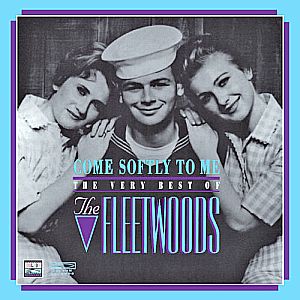
A Capitol Records CD featuring ‘the very best of’ the Fleetwoods, issued in 1993, decades after their big 1959 hit, ‘Come Softly To Me.’ Click for copy.
Over the next three decades, the Fleetwoods reunited occasionally to perform at concerts and in oldies revues. In 1990, a reassembled Fleetwoods group featuring Christopher and Troxell, plus new member Cheryl Huggins, played a round of American cities on an oldies tour after Rhino Records released their compact disc collection, The Best of the Fleetwoods.
The Fleetwoods’ two big hits have had periodic revivals through their use in various film soundtracks. “Come Softly To Me” was used in Stand by Me (1986), Clean and Sober (1988), and Crossing Delancey (1988). “Mr. Blue” was used in American Graffiti (1973), Return to Macon County (1975), American Hot Wax (1978, in which The Fleetwoods are portrayed as “Timmy & The Tulips”), and Diner (1982).
Made Their Mark
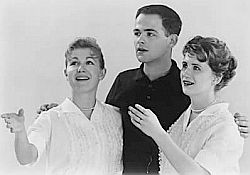
Studio photo of the Fleetwoods from the 1950s.
For more stories on the history of pop music at this website, see the “Annals of Music” category page, or go to the Archive for a broader selection of stories.
Thanks for visiting. – Jack Doyle
|
Please Support Thank You |
____________________________________
Date Posted: 6 June 2011
Last Update: 8 April 2022
Comments to: jdoyle@pophistorydig.com
Article Citation:
Jack Doyle, “Come Softly to Me, 1959-1963,”
PopHistoryDig.com, June 6, 2011.
____________________________________
Sources, Links & Additional Information
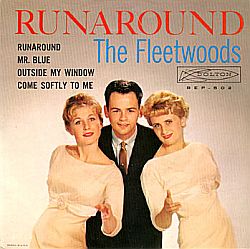 Cover of Fleetwoods’ “Runaround” EP issued under the Dolton record label. |
Charles Russell, “Teenagers Set To Start 3-Week Tour,” Seattle Post-Intelligencer, February 1959.
Peter Blecha,”Dolton: The Northwest’s First Rock ‘n’ Roll Record Company,”March 14, 2006, at: HistoryLinks.org, Essay #7636, Washington State Department of Archeology and Historic Preservation.
“The Fleetwoods,” in Holly George-Warren and Patricia Romanowski (eds), The Rolling Stone Encyclopedia of Rock & Roll, Rolling Stone Press, New York, 3rd Edition, 2001, pp. 337-338.
“Come Softly to Me,” Wikipedia.org.
“Fleetwoods Record Label Shots,” Color Radio.com, Disc jockey Brian Lee’s “Color Radio” is heard every Saturday evening from 4-6 PM Pacific coast time on community radio KVMR-FM. Nevada City, CA.
Howard A. DeWitt, “Teen Angst and Soft Rock ‘n Roll,” Rock & Blues News, 1999 (good, detailed article on The Fleetwoods’ history).
Steven Thomas Erlewine, “The Fleetwoods,” All Music Guide.
“The Fleetwoods,” HistoryofRock.com.
TheFleetwoods.com, Website (G. Christopher).
The Fleetwoods.us, Website.
“List of Number-One Singles of 1959 (U.S.),” Wikipedia.org.
______________________________
